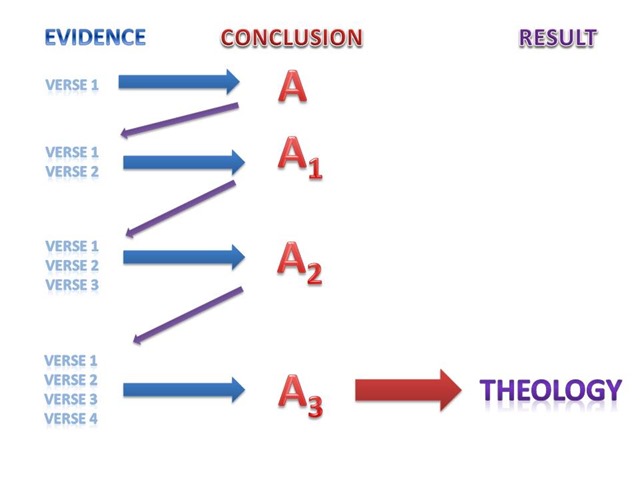This is the third part of our series on how to do Bible study. In the first article we learned how to understand what it is that we are reading when we read a specific translation of the Bible. In the second article we got to understand the context of each book in the Bible better. In this article we will now go one layer deeper into the phrases or verses that make up the Bible.
learned how to understand what it is that we are reading when we read a specific translation of the Bible. In the second article we got to understand the context of each book in the Bible better. In this article we will now go one layer deeper into the phrases or verses that make up the Bible.
This is normally the point in any Bible study where we need to start interpreting the words that we are reading. We sometimes need to move beyond the literal interpretation of the words we read. This puts us in a very dangerous place that could easily lead down the wrong path. We see in the book of 2 Peter, that this is nothing new. This problem has been around for many centuries.
2 Peter 3:14–16
14 Therefore, beloved, since you look for these things, be diligent to be found by Him in peace, spotless and blameless, 15 and regard the patience of our Master as salvation; just as also our beloved brother Paul, according to the wisdom given him, wrote to you, 16 as also in all his letters, speaking in them of these things, in which are some things hard to understand, which the untaught and unstable distort, as they do also the rest of the Scriptures, to their own destruction.
Peter gives us an indication on what we need to do to avoid this problem We need to start by ensuring that we are not untaught! Do not think that you can read the Bible like any other story book on your bookshelf. At the same time, do not go to the other extreme that requires only professionally trained people to interpret the Bible. We have been here before as well! Each one of use needs to make sure that we educate ourselves and that we have the correct guidance when reading the Bible. In scripture we also find the solution for this.
1 Corinthians 2:10–13
10 For to us YHVH revealed them through the Spirit; for the Spirit searches all things, even the depths of YHVH. 11 For who among men knows the thoughts of a man except the spirit of the man which is in him? Even so the thoughts of YHVH no one knows except the Spirit of YHVH. 12 Now we have received, not the spirit of the world, but the Spirit who is from YHVH, so that we may know the things freely given to us by YHVH, 13 which things we also speak, not in words taught by human wisdom, but in those taught by the Spirit, combining spiritual thoughts with spiritual words.
Thus we see from this message that we received the Spirit (Ruach) of YHVH so that we may know the things given to us by YHVH. From this we need to be sure that our primary source of understanding the Bible does not come from the books we read or the techniques we use, but from the Spirit that is within us. It is thus crucial that all your Bible studies include a lot of prayer time. By doing this the Spirit of YHVH will lead you to the depths of YHVH.
Having sais this, I still suggest that we learn the basics of how to read and understand the words of the Bible so that nobody calls us “untaught and unstable†and that we do not end up distorting the Scriptures.
The phrases of the Bible
As with the books of the Bible, the phrases or verses within a book of the Bible were written within a specific context. This context includes dimensions such as:
- time
- culture
- language
The phrases were written for a specific audience to address a specific topic. We need to be aware of these factors when we start to interpret Bible verses. These words were written for us but not to us. Thus we need to find a way to interpret these verses in such a way that we are able to apply them to our lives today. We need to find a way to move from one context to the next without distorting the message. If you understand the context of the culture you will look at this verse differently :
Proverbs 28:22
22 A man with an evil eye hastens after wealth And does not know that want will come upon him.
What exactly does the evil eye of an man have to do with hastening after wealth? The phrase “an evil eye†needs to be understood in it’s original Hebraic context in order for this Proverb to make complete sense. “Having an evil eye†actually refers to somebody that is stingy with money or very greedy. If you look at a different translation you will see this being reflected in the text. The same verse in the Holman Christian Study Bible:
Proverbs 28:22
22 A greedy man is in a hurry for wealth; he doesn’t know that poverty will come to him.
Thus the phrase had a different meaning in the original context. We see that the term “an evil eye†is not to be read literally. This is not a person whose one eye is wicked or bad.
Another good example to consider:
Malachi 1:2–3
2 “I have loved you,†says YHVH. But you say, “How have You loved us?†“Was not Esau Jacob’s brother?†declares YHVH. “Yet I have loved Jacob; 3 but I have hated Esau, and I have made his mountains a desolation and appointed his inheritance for the jackals of the wilderness.â€
 Does this really mean that YHVH hated Esau in the same way as we would interpret the word “hate� What did Esau do that YHVH would hate him? Once again we need to go back to the Hebraic way of speaking in order to understand the verse correctly. What the author is using here is a technique of contrasts to emphasize. The point here is not that YHVH hated Esau, but that YHVH really loved Jacob! The contrast between love and hate is simply to illustrate that YHVH made a choice for Jacob and not for Esau. Here is a more detailed explanation:
Does this really mean that YHVH hated Esau in the same way as we would interpret the word “hate� What did Esau do that YHVH would hate him? Once again we need to go back to the Hebraic way of speaking in order to understand the verse correctly. What the author is using here is a technique of contrasts to emphasize. The point here is not that YHVH hated Esau, but that YHVH really loved Jacob! The contrast between love and hate is simply to illustrate that YHVH made a choice for Jacob and not for Esau. Here is a more detailed explanation:
How is it that Israel was in a special covenant relationship with God? It was because the Lord had made a choice. He chose Jacob and rejected Esau!
The Lord’s statement that he ‘hated’ Esau has caused no small amount of consternation among Bible students. What does it mean? Joyce Baldwin offers this explanation:
God’s love for Israel in the past had also been borne out by his providential care of her. While he had blessed her with the land of Canaan—‘flowing with milk and honey’—the descendants of Esau (Edom) had been left without such a land. 1
And another way of explaining it:
The Hebrew words for loved and hated refer not to God’s emotions but to His choice of one over the other for a covenant relationship (cf. Gen. 29:31-35; Deut. 21:15, 17; Luke 14:26). To hate someone meant to reject him and to disavow any loving association with him (cf. Ps. 139:21). Nor do these words by themselves indicate the eternal destinations of Jacob and Esau. The verbs refer to God’s acts in history toward both of the two nations which descended from the two brothers.
Thus we see in both explanations that the words are not related to the meaning that we would associate to them if we were to read a modern English book. Modern English writers would use these words only to indicate the emotions of the person. That would give this verse a complete different meaning.
Another important aspect of the verse would be to take note of the genre (as mentioned in the previous article) of the specific text. This will lead us to what our default way for interpreting should be: literal or metaphorical. If I read one of the historical books of the Bible, I would tend to default to literal interpretation. However, when reading an apocalyptical book like Revelation, I would tend to default to a metaphorical interpretation.
Why do we study the phrases?
From the two examples above you should already have some indication as to why we need to study the phrases in order to come to a point where we understand what we are reading and are able to apply it to our own lives.
A key part of this is ensuring that we read these verses within the context of the complete Bible. When reading a phrase or verse we need to always ensure “synthesis†also known as “analogia scripturaâ€. This simply means that all scriptures together need to come together to a coherent message. We cannot have verses in the Bible that contradict one another. If we are in this situation it normally means that we do not understand at least one of the verses correctly.
If we have all the verses that relate to a specific topic neatly lined up, we get to what is called a “theologyâ€. Theology is simply the activity of thinking and/or speaking about YHVH. The outcome of this process is called theology. The diagram below shows the process of interpreting the verses and getting to a theology.
Every time we find another verse that sheds more light on the topic we enhance or alter our conclusion. At the point where we have studied all the verses and we get to a final conclusion then we have a theology regarding the topic.
In the academic world, theology is again subdivided into:
- Biblical Theology – This refers to the unity between the Tanach and the Apostolic Writings. It ensures that all that is written in the Bible regarding one specific topic is aligned (synthesis).
- Systematic Theology – This ensures that we put the different concepts from Biblical Theology together into a harmonized system. Thus will be creating a structure into which we can place all the different topics. We also need to ensure that all the topics again align to one harmonized message.
- Normative Theology – How the truths from the Bible are used to determine the ethics and norms for us today.
All of this indicates that we must not try to interpret any single phrase or verse in isolation from the rest of the Bible. Any interpretation we come up with must be consistent with the bigger picture of the complete Bible. Thus we always need to think further that the individual phrase before we can make a final interpretation of exactly what this verse means for us today.
How do we study the phrases
In order to ensure that we interpret the verses or phrases of the Bible accurately we need to ensure that we have a solid method for moving from the verses in the Bible to the rules and norms we set for ourselves. Thus we need to ensure that we study the Biblical texts correctly in the context of it’s author and addressees.
During this process we need to guard against our own personal interpretation. Our personal interpretation could be influenced by theories we have heard before or by the traditions that we are following in our lives. As an example, when we study the topic of the redemptive work that Y’Shua has done for us the topic of sacrifices come up. Then our next topic is to study the redemptive nature of sacrifices. Here some of us will be influenced by the theory that have floating around for a while – “Sacrifices can only atone for unintentional sinâ€. This theory is based partially on the following verses:
Numbers 15:29–31
29 ‘You shall have one law for him who does anything unintentionally, for him who is native among the sons of Israel and for the alien who sojourns among them. 30 ‘But the person who does anything defiantly, whether he is native or an alien, that one is blaspheming YHVH; and that person shall be cut off from among his people. 31 ‘Because he has despised the word of YHVH and has broken His commandment, that person shall be completely cut off; his guilt will be on him.’ â€
However, when we read the following verses, we see that this cannot be that clear cut.
Leviticus 6:2–7
2 “When a person sins and acts unfaithfully against YHVH, and deceives his companion in regard to a deposit or a security entrusted to him, or through robbery, or if he has extorted from his companion, 3 or has found what was lost and lied about it and sworn falsely, so that he sins in regard to any one of the things a man may do; 4 then it shall be, when he sins and becomes guilty, that he shall restore what he took by robbery or what he got by extortion, or the deposit which was entrusted to him or the lost thing which he found, 5 or anything about which he swore falsely; he shall make restitution for it in full and add to it one-fifth more. He shall give it to the one to whom it belongs on the day he presents his guilt offering. 6 “Then he shall bring to the priest his guilt offering to YHVH, a ram without defect from the flock, according to your valuation, for a guilt offering, 7 and the priest shall make atonement for him before YHVH, and he will be forgiven for any one of the things which he may have done to incur guilt.â€
These verses indicate that a person who has deceived or robbed another or has lied about it and sworn falsely (something I do not believe can be done unintentionally) must make restoration, take a guilt offering to the priest, have this offered for atonement and then he will be forgiven. If you were to stick to this theory during your interpretation you may have some troubles reconciling all the scriptures.
this offered for atonement and then he will be forgiven. If you were to stick to this theory during your interpretation you may have some troubles reconciling all the scriptures.
The process of moving from the text to the interpretation is called “exegesisâ€.
Over and above the points we have already discussed like: historical context, genre and the source text, we still need to examine a couple of other aspects. These include the structure of the sentences and grammar being used. This will allow us to get a much clearer understanding of the logic contained in the verse or phrase.
The rules and methods that we use when we move from text to interpretation is called “hermeneuticsâ€.
The Greek verb hermēneúŠhas given the name to that aspect of theological study known as hermeneutics. In brief, hermeneutics has traditionally been understood to be the working out of rules and methodologies for interpreting scriptural texts.5
Once we have gotten to a better understanding of the phrase (or phrases), we can start our attempt of interpretation. As previously stated we must be careful not to end up with personal interpretation.
Different Hermeneutical Systems
Over the years many different systems have been developed to ensure consistent and accurate interpretation. Each of these systems define a different set of of rules for interpretation. It is extremely difficult to come up with one set of rules that cover all genres of texts across all time periods.
The first forms of interpretation that we currently have record of are the Targums. These were translations and interpretation of the Hebrew scriptures into Aramaic. We do not have any guidance to the rules that were used, if any, to create these interpretations. We see the first record of these formalized rule sets originating early in the rabbinical system. The first of such systems is “The 7 rules of Rabbi Hillel the elder.†Rabbi Hillel lived during the same time period as Y’Shua and it is claimed that he was the leader of the Pharisees between 30 B.C. and 10 A.D. as well as the president of the Sanhedrin.6 His followers continued his teachings as “the school of Hillel.†The basics of these seven rules are:
- Inference from the lighter meaning (= minor premise) to the heavier (= major premise), or an a fortiori argument. This simply says that what is true of the lesser is true also of the greater. Thus, since the Sabbath was more important than the other festival days, a restriction placed on an annual festival day was even more applicable to the Sabbath day.
- Analogy of expressions. Ambiguous passages were explained by drawing an inference from similar words and phrases used elsewhere. Accordingly, since Leviticus 16:29 requires Jews to “afflict [their] souls†(KJV) on the Day of Atonement, without explaining what the nature of that affliction is, it was interpreted to mean that Jews should abstain from food on Yom Kippur, since the same expression is used in Deuteronomy 8:3 with explicit mention of hunger.
- Application by analogy with one provision, or the extension from the specific to the general. In this rule, texts were applied to cases if they were similar in nature, even though they were not directly covered in the Scripture cited. In other words, a general principle was constructed on the basis of a teaching contained in one verse. So, for example, the case of the accidental killing of a fellow woodsman in Deuteronomy 19 could be applied to any accidental death resulting from two men working together in a public place.
- Application by analogy with two provisions. This rule is similar to the previous rule, only here it is strengthened by giving two provisions, or two verses, for the general principle. For example, Exodus 21:26–27 provided that a slave that had his “eye†or “tooth†destroyed could go free. By analogy, this rule could be extended to all other parts of the body.
- Inference from a general principle to a specific case or example. This rule may be used either way—from the general to the specific or vice versa. Thus, Exodus 22:9 states that if a man lends another his ox, donkey, sheep, garment, “or any other … property,†he must pay double restitution if it is lost. But since the generalizing term “any other thing†is used, it shows that the ox, the donkey, the sheep, and the garment were only examples, and thus the law applies to any borrowed thing that is lost, living or dead; it must be refunded for twice its value.
- Explanation from another passage. Similar to the second rule, this rule explained one passage by appealing to another scripture. The question arose for Rabbi Hillel whether the Passover lamb was to be slain on a Sabbath, if the fourteenth of Nisan fell on the Sabbath day. He replied that since Numbers 28:10 decreed that the “daily†sacrifices had to be offered also on the Sabbath, then by analogy the Passover lamb had to be slain on the fourteenth of Nisan, regardless of what day it fell on.
- Application of self-evident inferences from the context. A passage must not be taken as an isolated statement, but only in the light of its context. Therefore, the apparently absolute prohibition against going out of the house on the seventh day in Exodus 16:29 must be interpreted in its context to apply only to the situation of gathering of manna in the wilderness, which was to have been provided for by gathering double on the day before. 7
These seven rules were later extended to 13 by Rabbi Ishmael and then again to 32 rules by Rabbi Eliezar ben JosÄ“. Now additional methods like gematria (the calculation of the numerical values of letters in order to obtain deeper meaning when comparing them with other words yielding that have the same numerical value) and nÅtrikon (the breaking up of one word into two or more, or the reconstructing of a word by using the initials of many words) started to appear to allow people to move beyond the literal meaning of the words.
In the apostolical period (the time of the apostles after the resurrection of Y’Shua), the main principle of hermeneutics was the fulfillment of prophecy. Most of the authors for this period (John, Peter, Luke, James and Paul) used the scriptures of the Tanach to show how Y’Shua was the Messiah. This concept was carried over in the period of the Apostolic Fathers in the second century.
In the third century we see a split in the approaches. The school of Alexandria started to stress allegorical readings. This means that often the texts where spiritualized at the expense of the literal meaning.  This school included Origen and Clement of Alexandria. The Antiochene school stressed a more literal and historical reading of the scriptures. This school included people like Theodore of Mopsuestia and John Chrysostom.
In the fourth century we see the shift towards the fourfold meaning of scripture. The four senses in which scripture was interpreted included
- literal
- allegorical
- moral
- heavenly
Here we see an example of how the believers in Y’Shua used this in the fourth century:
This fourfold interpretation supplied a full and complete analysis of the text, so that Genesis 1:3 (“Let there be lightâ€) now meant (1) the creation in a literal sense; (2) “may we be illumined in mind and inflamed in heart through Christ†in the moral sense; (3) “let Christ be formed in the church†in the allegorical meaning; and (4) “may we be conducted to glory through Christ†in an anagogical sense.
In the Jewish community this was also used in what is now commonly known as “PaRDeSâ€. This system also teaches that scripture can be interpreted at four levels:
- P’Shat – the literal sense
- Remez – allegorical
- Derash – metaphorical
- Sod – Secret of mystical
Below is a table that provides a good high level summary of this hermeneutical system. For a more in depth study on this topic please read this article.
|
P´Shat |
Remez |
Derash |
Sod |
|
| Definition |
Simple |
Hint |
Explore – Ask |
Secret |
| Literary level |
Grammatical |
Allegory |
Parabolic |
Mystical |
| Audience level |
Common People |
Noble |
Kingly |
Mystic |
| Hermeneutic level |
7 Hillel Laws |
13 Ishmael Laws |
32 Ben Gallil Laws |
42 Zohar Laws |
| Rabbinic level |
Mishna |
Gemara |
Midrash |
Zohar |
Use of the hermeneutics and interpretation in the Apostolic Scriptures
As the Apostolic Writings build upon what is written in the Tanach, we see the authors of the books quoting the Tanach quite often. When quoting the verses of the Tanach we see these hermeneutics being used frequently. It is not limited to one specific author, like Paul, but appears in the words of Y’Shua, Peter, Paul and the author of Hebrews. Below you will find a table that provides you with some examples of the use of these hermeneutics in the Apostolic Scriptures.
| Hebrew | English | Explanation | Scripture | Explanation |
| Kal vaHomer | Light and Heavy | From the Minor to the Major | Matt 6:25 – 33 | If YHVH takes care of the birds, how much more would He take care of us? |
| G’zerah Shavah | Equal Cut | Once one finds a common word, phrase or root in 2 passages, an analogy can be made | Heb 3:13-15 | The use of the word “day”and “today” is based upon Psalm 95:7-11 and Gen 2:2 |
| Binyan av Mikatuv echad | Making up a family from one text | When an idea is found in several different passages, one can draw the conclusion of the cumulative effect | Heb 9:11-22 | The ideas of “blood” from sacrificial and covenantal contexts in the Torah (Exo 24:6-8, Lev 8:15-19, Num 19:4-18) and the idea of covenant in Jer 31:34 |
| Binyan av mish’nei ketuvim | Making up a family from one or more text | The application comes from combining two different texts and then applying the concepts in both to a “family” of other passages | Heb 1:5-14 | Puts Psalm 2:7 and 2 Sam 7:14 together to prove that Messiah was greater than the angels. |
| K’lal Uf’rat | General to the particular | A major principle is stated and then expanded and listed below into greater detail. | 2 Cor 6:14-17 | “Do not be unequally yoked” is the general principle and then Paul expands and details this principle. |
| Kayotzei bo mimakom acher | Analogy made from another passage | Compare two passage that appear to contradict one another with a third passage that contains some of the same general ideas in order tot resolve the apparent contradiction | 2 Peter 2:4-8 | Explains the apparent contradiction between Isa 28:16 and Psalm 118:22 by inserting Isa 8:13:15 to show that it is the disobedient that stumbles over a stone. |
| Davar ha-nilmad me-inyano | Explanation obtained from context | A text must be examined within it’s total context if it is to be understood properly. | Rom 14:1 | If one ignores the general context of Paul’s letter to the Romans, one could come to the conclusion that Paul annulled all the dietary laws of the Torah. |
| Hekkesh | Take two stones and hit them together | Comparing two verses that have similar language in order to learn something not previously known. | Matt 5:27-28 | Y’Shua combines two of the ten commandments “You shall not commit adultery” and “You shall not covet” to make the conclusion that the Torah’s prohibition on adultery also includes broader sins than simply the physical act of having sexual relations. Y’Shua was able to combine these two commandments because the Septuagint’s word for “covet” in the ten commandments is the same Greek verb (epithymeo) that He uses in this verse for “lust“. |
Y’Shua and hermeneutics
As per the table above, we know that Y’Shua also used these techniques in His teachings. By this we cannot imply that Y’Shua followed the teachings of the school of Hillel, but we do see that He also used techniques similar to those recorded by Rabbi Hillel.
Challenge to all: Below I will provide you with some more of Y’Shua’s teachings. See if you can work out what technique you would ascribe to each of these sayings. Leave you answers in the comments below the article.
Mark 2:25–28
25 And He said to them, “Have you never read what David did when he was in need and he and his companions became hungry; 26 how he entered the house of YHVH in the time of Abiathar the high priest, and ate the consecrated bread, which is not lawful for anyone to eat except the priests, and he also gave it to those who were with him?†27 Y’Shua said to them, “The Sabbath was made for man, and not man for the Sabbath. 28 “So the Son of Man is Lord even of the Sabbath.â€John 7:23–24
23 “If a man receives circumcision on the Sabbath so that the Law of Moses will not be broken, are you angry with Me because I made an entire man well on the Sabbath? 24 “Do not judge according to appearance, but judge with righteous judgment.â€John 10:34–36
34 Y’Shua answered them, “Has it not been written in your Law, ‘I said, you are gods’? 35 “If he called them gods, to whom the word of YHVH came (and the Scripture cannot be broken), 36 do you say of Him, whom the Father sanctified and sent into the world, ‘You are blaspheming,’ because I said, ‘I am the Son of YHVH’?
Here is another very interesting description of the methods that Y’Shua used to explain the topics;
Paul’s use of hermeneutics
Paul described himself as a Pharisee of Pharisees and also mentions to us that he studied under one of the most famous Jewish rabbis.
Acts 22:3
3 “I am a Jew, born in Tarsus of Cilicia, but brought up in this city, educated under Gamaliel, strictly according to the law of our fathers, being zealous for YHVH just as you all are today.Acts 23:6
6 But perceiving that one group were Sadducees and the other Pharisees, Paul began crying out in the Council, “Brethren, I am a Pharisee, a son of Pharisees; I am on trial for the hope and resurrection of the dead!â€Acts 26:4–5
4 “So then, all Jews know my manner of life from my youth up, which from the beginning was spent among my own nation and at Jerusalem; 5 since they have known about me for a long time, if they are willing to testify, that I lived as a Pharisee according to the strictest sect of our religion.
If Paul was educated by Gamaliel, a member of the council (Acts 5:34), Paul must have been familiar with all these hermeneutics that were being used. We can assume that he had been trained in the Jewish way of studying the Tanach. It would therefor be reasonable to make the assumption that Paul would make use of these techniques in his writings. So when Paul starts to proclaim Y’Shua, we can assume that he would continue to use these techniques.
In the table above we see two examples of Paul using some of the techniques in his writing. One of the techniques that Paul uses very frequently is Kal vaHomer (Light to heavy). By simply searching for the phrase “May it never be†in my New American Standard translation, I was able to find at least 14 occurrences. Some examples for you:
Romans 3:31
31 Do we then nullify the Law through faith? May it never be! On the contrary, we establish the Law.Romans 7:7
7 What shall we say then? Is the Law sin? May it never be! On the contrary, I would not have come to know sin except through the Law; for I would not have known about coveting if the Law had not said, “You shall not covet.â€Romans 11:11
11 I say then, they did not stumble so as to fall, did they? May it never be! But by their transgression salvation has come to the Gentiles, to make them jealous.
Paul also makes use of allegory to explain some concepts. We see him specifically using Hagar and Sarah to refer to two covenants.
Galatians 4:24–31
24 This is allegorically speaking, for these women are two covenants: one proceeding from Mount Sinai bearing children who are to be slaves; she is Hagar. 25 Now this Hagar is Mount Sinai in Arabia and corresponds to the present Jerusalem, for she is in slavery with her children. 26 But the Jerusalem above is free; she is our mother. 27 For it is written,
“Rejoice, barren woman who does not bear;
Break forth and shout, you who are not in labor;
For more numerous are the children of the desolate
Than of the one who has a husband.â€
28 And you brethren, like Isaac, are children of promise. 29 But as at that time he who was born according to the flesh persecuted him who was born according to the Spirit, so it is now also. 30 But what does the Scripture say?
 “Cast out the bondwoman and her son,
For the son of the bondwoman shall not be an heir with the son of the free woman.â€
31 So then, brethren, we are not children of a bondwoman, but of the free woman.
But why does Paul use this technique? I came across this interesting explanation:
Paul also showed quite a bit of his exposure to midrash in his teachings. One very clear example of Jewish midrash showing up in the writings of Paul can be found here:
1 Corinthians 10:1–6
1 For I do not want you to be unaware, brethren, that our fathers were all under the cloud and all passed through the sea; 2 and all were baptized into Moses in the cloud and in the sea; 3 and all ate the same spiritual food; 4 and all drank the same spiritual drink, for they were drinking from a spiritual rock which followed them; and the rock was Messiah. 5 Nevertheless, with most of them YHVH was not well-pleased; for they were laid low in the wilderness. 6 Now these things happened as examples for us, so that we would not crave evil things as they also craved.
The rock with water that followed the Israelites through the wilderness is a well known Jewish midrash. Here we can see Paul using this and then even using allegory to link Y’Shua with this rock.
Other examples in the Apostolic Scriptures
Jude 9
9 But Michael the archangel, when he disputed with the devil and argued about the body of Moses, did not dare pronounce against him a railing judgment, but said, “YHVH rebuke you!â€
 In this verse we see another example of Jewish midrash included in the Apostolic Scriptures. This concept of Michael arguing with haSatan does not appear in any of the books in the Tanach. So where did Jude get this from? We see some explanations in the following text by David Stern:
In this verse we see another example of Jewish midrash included in the Apostolic Scriptures. This concept of Michael arguing with haSatan does not appear in any of the books in the Tanach. So where did Jude get this from? We see some explanations in the following text by David Stern:
Here Y’hudah reportedly alludes to a story included in the Testament of Moses, a Jewish writing from the beginning of the first century C.E.; although some portions of it have survived, the relevant ones have not. However, elements of the legend are found elsewhere. Deuteronomy Rabbah 11:10 reports a dispute an hour before Moses’ death between Samma’el—regarded in Judaism as the angel of death and often identified with the Adversary (Satan, the accuser; see Mt 4:1N)—and Mikha’el (Michael; who, on the basis of Daniel 10:13, 21; 12:1, is regarded in Jewish tradition as Israel’s defender and Satan’s opponent; see Rv 12:7&N). Targum Yonatan says that Moses’ tomb was put under Mikha’el’s authority. The Testament of Moses must have added that God assigned Mikha’el to bury Moses’ corpse, but when Satan claimed it as his Mikha’el took issue with the Adversary, arguing over the body of Moshe.
Thus, either Jude had access to the book called “Testament of Mosesâ€, as also claimed by Clement of Alexandria, Origen, and Didymus, or he is building on some of the teachings that can be found in the Jewish midrash.
For our last example, let us see how a very simple piece of text can get a lot added via midrash. Let us start with the source of the discussion:
Deuteronomy 33:2
2 He said, “YHVH came from Sinai, And dawned on them from Seir; He shone forth from Mount Paran, And He came from the midst of ten thousand holy ones; At His right hand there was flashing lightning for them.
We see here mention in the scriptures of angels (holy ones) being with YHVH as the commandments were given on Mount Sinai. We find proof of this idea in three different verses by three different authors in the Apostolic Scriptures.
Acts 7:52–53
52 “Which one of the prophets did your fathers not persecute? They killed those who had previously announced the coming of the Righteous One, whose betrayers and murderers you have now become; 53 you who received the law as ordained by angels, and yet did not keep it.â€Hebrews 2:2
2 For if the word spoken through angels proved unalterable, and every transgression and disobedience received a just penalty,Galatians 3:19
19 Why the Law then? It was added because of transgressions, having been ordained through angels by the agency of a mediator, until the seed would come to whom the promise had been made.
Messianic Hermeneutics
In the Messianic community we do not yet have any formal or agreed hermeneutics. A lot of students still apply the basics that they had previously learned, either from Christianity or Judaism. Although this is not wrong, it does not reflect the real and complete view of the Messianic movement.
In my studies, I have come across a wonderful little book called “Hidden Treasures: The First Century Jewish Way of Understanding the Scriptures†by Joseph Shulam. He gives a good overview of the topic we have discussed so far. He also has a chapter in the book entitled “Messianic Jewish Hermeneutics†where he discusses this topic of an unique approach for the Messianic movement. To summarize, he proposes some basic guidelines that could be used. These are as follows 11:
- The Bible is the Word of YHVH and should be treated as such.
- The Bible is a very ancient document and should be treated as such.
- The Bible was not written in English. It is important for us to remember that whenever we study a translation, we are already beginning with an interpretation.
- The Bible is a Jewish document and should be treated as such.
- The Bible contains different types of literature. Each genre needs to be discerned and treated with the appropriate linguistic tools.
- The Bible reflects a historical reality which must be understood within that context.
- The Bible, as the Word of YHVH, communicates YHVH’s will. There is a spiritual dimension to the Bible which entails more than a series of words, sentences and chapters. It is also more than literature.
- One needs the guidance of the Ruach haChodesh along with the proper use of hermeneutics to fully understand the words and discern the spirit of the Word.
Although this is not a complete list or a definite hermeneutical system, it does provide us with a good place to start. This is one of the key things that the Messianic community will need to get in place if we want to grow and be taken serious by theologians and academics.
Conclusion
So let us summarize what we have learned today:
- We need to start our Bible study with prayer. This will allow the Spirit of YHVH (Ruach ha Kodesh) to lead us in the Word.
- When we get to studying the verse, we need to start interpreting the words we read. These words were written in a different context than the one we are trying to apply them to. Thus we need some rules and techniques to move from the one context to the next.
- We need to ensure that the interpretation stays in line with all of Scripture. We need to actively remove all perceived contradictions by re-examining these verses until we have a coherent view of all verses. The same needs to be done at a higher level to ensure that all concept are also aligned in our theology.
- Guard against personal interpretation, it could lead to these apparent contradictions.
- Different hermeneutical system exist. These have evolved over time. In order to understand all of the Apostolic Scriptures, we need to understand the hermeneutics that the authors used. When looking at the PaRDeS system, I could not find any use of Sod (mystical) hermeneutics. I personally do not believe that we should be studying at this “levelâ€. It has lead to many false teachings. Please see our article on this topic.
- No hermeneutical system exists in the messianic movement at the moment. It is one of many crucial things we need to get in place if we want to be taken seriously.
Why do we need to learn about all these things? Simply put – to avoid “junk scholarship.†This means that if we all ensure that we are not “untaught and unstableâ€, we will produce Bible studies that will be taken serious by our peers and not be seen as producing “biased and cultic†studies with no sound foundation.
To continue reading: Bible Study – Part 4 – How to study the words of the BibleÂ
References
- Ellsworth, R. (2007). Opening up Malachi. Opening Up Commentary (20–21). Leominster: Day One Publications.
- Walvoord, J. F., Zuck, R. B., & Dallas Theological Seminary. (1985). The Bible Knowledge Commentary: An Exposition of the Scriptures (Mal 1:2). Wheaton, IL: Victor Books.
- Stuart, D. (1992). Exegesis. In D. N. Freedman (Ed.), . Vol. 2: The Anchor Yale Bible Dictionary (D. N. Freedman, Ed.) (682). New York: Doubleday.
- Lategan, B. C. (1992). Hermeneutics. In D. N. Freedman (Ed.), . Vol. 3: The Anchor Yale Bible Dictionary (D. N. Freedman, Ed.) (149). New York: Doubleday.
- Vol. 2: The International Standard Bible Encyclopedia, Revised. 1988 (G. W. Bromiley, Ed.) (863). Wm. B. Eerdmans.
- Patzia, Arthur G., and Anthony J. Petrotta. Pocket Dictionary of Biblical Studies. Downers Grove, IL: InterVarsity Press, 2002. Entry on Hillel.
- Kaiser, W. C., Jr. (2007). A Short History of Interpretation. In W. C. Kaiser, Jr. & M. Silva (Eds.), Introduction To Biblical Hermeneutics: The Search for Meaning (W. C. Kaiser, Jr. & M. Silva, Ed.) (259–260). Grand Rapids, MI: Zondervan.
- Deppe, D. B. (2011). All Roads Lead to the Text: Eight Methods of Inquiry into the Bible (237). Grand Rapids, MI; Cambridge, U.K.: William B. Eerdmans Publishing Company.
- Deppe, D. B. (2011). All Roads Lead to the Text: Eight Methods of Inquiry into the Bible (174–175). Grand Rapids, MI; Cambridge, U.K.: William B. Eerdmans Publishing Company.
- Stern, D. H. (1996). Jewish New Testament Commentary : A companion volume to the Jewish New Testament (electronic ed.) (Jud 9). Clarksville: Jewish New Testament Publications.
- Shulam, Jospeh, Hidden treasures: The first century Jewish way of understanding the Scriptures, http://www.netivyah.org, ISBN 978-0-9818730-0-8











Leave a Reply